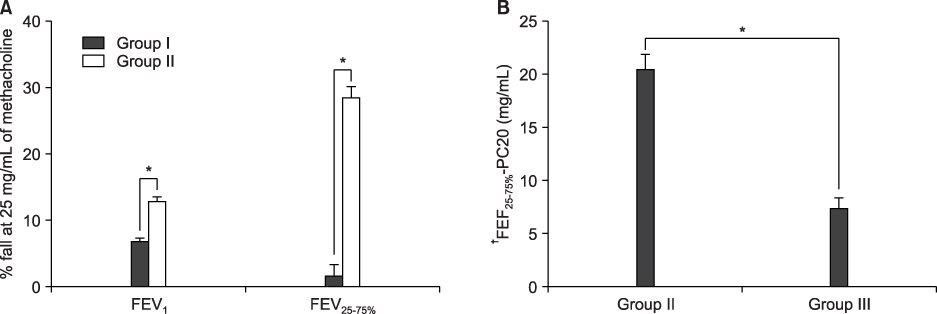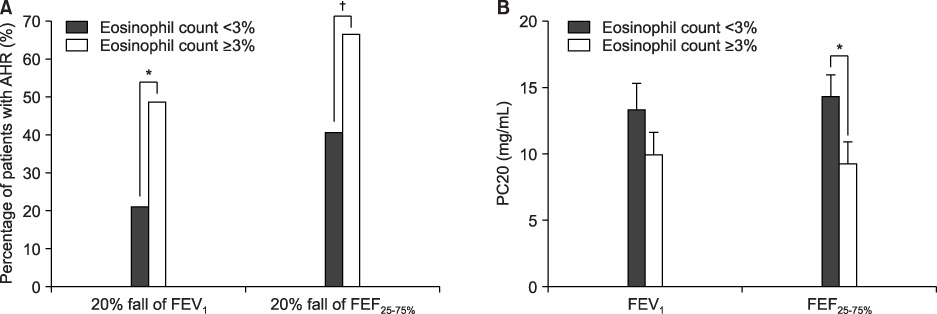Tuberc Respir Dis.
2009 Oct;67(4):311-317.
Role of Methacholine PC20 in FEF(25-75%) for the Diagnosis of Bronchial Asthma
- Affiliations
-
- 1Division of Pulmonary, Allergy, and Critical Care Medicine, Sacred Heart Hospital, Hallym University College of Medicine, Anyang, Korea. chestor@hallym.or.kr
Abstract
- BACKGROUND
The methacholine bronchial provocation test is a useful tool for evaluating asthma in patients with normal or near normal baseline lung function. However, the sensitivity of this test is 82~92% at most. The purpose of this study is to evaluate the clinical usefulness of FEF(25-75%) in identification of airway hyperresponsiveness in patients with suspected asthmatic symptoms.
METHODS
One hundred twenty-five patients who experienced cough and wheezing within one week prior to their visiting the clinic were enrolled.
RESULTS
Sixty-four subjects showed no significant reduction of FEV1 or FEF(25-75%) on the methacholine bronchial provocation test (Group I). In 24 patients, FEF(25-75%) fell more than 20% from baseline without a 20% fall of FEV1 during methacholine challenge (Group II). All patients who had more than 20% fall of FEV1 (n=37) also showed more than 20% of reduction in FEF(25-75%) (Group III). Baseline FEV1/FVC (%) and FEF(25-75%) (L) were higher in group II than group III (81.51+/-1.56% vs. 75.02+/-1.60%, p<0.001, 3.25+/-0.21 L vs. 2.45+/-0.21 L, p=0.013, respectively). Group II had greater reductions of both FEV1 and FEF(25-75%) than group I at 25 mg/mL of methacholine (p<0.001). The provocative concentration of methacholine causing a 20% fall in FEF(25-75%) in group II was about three-fold higher than that in group III.
CONCLUSION
A 20% fall of FEF(25-75%) by methacholine provocation can be more sensitive indicator for detecting a milder form of airway hyperresponsiveness than FEV1 criteria.
Keyword
MeSH Terms
Figure
Reference
-
1. Sistek D, Tschopp JM, Schindler C, Brutsche M, Ackermann-Liebrich U, Perruchoud AP, et al. Clinical diagnosis of current asthma: predictive value of respiratory symptoms in the SAPALDIA study. Swiss Study on Air Pollution and Lung Diseases in Adults. Eur Respir J. 2001. 17:214–219.2. Cockcroft DW. Adkinson NF, Middleton E, editors. Chapter 73. Bronchial challenge testing. Middleton's allergy: principles & practice. 2009. 7th ed. Philadelphia: Mosby Elsevier;1295–1305.3. Cockcroft DW, Murdock KY, Berscheid BA, Gore BP. Sensitivity and specificity of histamine PC20 determination in a random selection of young college students. J Allergy Clin Immunol. 1992. 89:23–30.4. Song HJ, Chung JW, Choi JH, Suh CH, Nahm DH, Park HS. Clinical significance of bronchial hyperresponsiveness to adenosine 5-monophosphate in bronchial asthma. J Asthma Allergy Clin Immunol. 2004. 24:299–304.5. Lee BJ, Min TH, Choi DC. Ever wheeze as a predictor of cough variant asthma. J Asthma Allergy Clin Immunol. 2004. 24:94–102.6. Chai H, Farr RS, Froehlich LA, Mathison DA, McLean JA, Rosenthal RR, et al. Standardization of bronchial inhalation challenge procedures. J Allergy Clin Immunol. 1975. 56:323–327.7. Crapo RO, Casaburi R, Coates AL, Enright PL, Hankinson JL, Irvin CG, et al. Guidelines for methacholine and exercise challenge testing-1999. This official statement of the American Thoracic Society was adopted by the ATS Board of Directors, July 1999. Am J Respir Crit Care Med. 2000. 161:309–329.8. Cockcroft DW, Davis BE, Todd DC, Smycniuk AJ. Methacholine challenge: comparison of two methods. Chest. 2005. 127:839–844.9. Allen ND, Davis BE, Hurst TS, Cockcroft DW. Difference between dosimeter and tidal breathing methacholine challenge: contributions of dose and deep inspiration bronchoprotection. Chest. 2005. 128:4018–4023.10. Perpina M, Pellicer C, de Diego A, Compte L, Macian V. Diagnostic value of the bronchial provocation test with methacholine in asthma: a Bayesian analysis approach. Chest. 1993. 104:149–154.11. Marseglia GL, Cirillo I, Vizzaccaro A, Klersy C, Tosca MA, La Rosa M, et al. Role of forced expiratory flow at 25-75% as an early marker of small airways impairment in subjects with allergic rhinitis. Allergy Asthma Proc. 2007. 28:74–78.12. Simon MR, Havstad S, Cotronei C, Krell W, Johnson CC, Peterson EL. Assessment of mid flow rate measurements in patients undergoing methacholine challenge. Allergy Asthma Proc. 2006. 27:404–410.13. Lebecque P, Kiakulanda P, Coates AL. Spirometry in the asthmatic child: is FEF25-75 a more sensitive test than FEV1/FVC? Pediatr Pulmonol. 1993. 16:19–22.14. Rhee KH, Kim JK, Kim JH, Lim DH, Son BK. Usefulness of FEF25-75% in methacholine bronchial provocation test in children with asthma. Pediatr Allergy Respir Dis. 2005. 15:408–414.15. Keatings VM, Evans DJ, O'Connor BJ, Barnes PJ. Cellular profiles in asthmatic airways: a comparison of induced sputum, bronchial washings, and bronchoalveolar lavage fluid. Thorax. 1997. 52:372–374.16. Sosa IP, Nanulescu M. Induced sputum--means for detecting bronchial inflammation in children with atopic bronchial asthma and treatment monitoring. Pneumologia. 2004. 53:79–84.17. Louis R, Bettiol J, Cataldo D, Bureau F, Seumois G, Radermecker M, et al. Value of induced sputum in the investigation of asthma. Rev Mal Respir. 2003. 20:215–223.18. Berry MA, Hargadon B, McKenna S, Shaw D, Green RH, Brightling CE, et al. Observational study of the natural history of eosinophilic bronchitis. Clin Exp Allergy. 2005. 35:598–601.19. Park SW, Lee YM, Jang AS, Lee JH, Hwangbo Y, Kim DJ, et al. Development of chronic airway obstruction in patients with eosinophilic bronchitis: a prospective follow-up study. Chest. 2004. 125:1998–2004.
- Full Text Links
- Actions
-
Cited
- CITED
-
- Close
- Share
- Similar articles
-
- Analysis of PC20-FEF25%-75% and △FVC in the methacholine bronchial provocation test
- Characteristics and Follow-Up of Bronchial Hyperresponsiveness in Cough Variant Asthma
- Relationship between duration of disease and bronchial responsiveness in 6-8 years old children with asthma
- Clinical Significance of Bronchial Hyperresponsiveness to Adenosine 5-monophosphate in Bronchial Asthma
- Usefulness of FEF25-75% in Methacholine Bronchial Provocation Test in Children with Asthma



